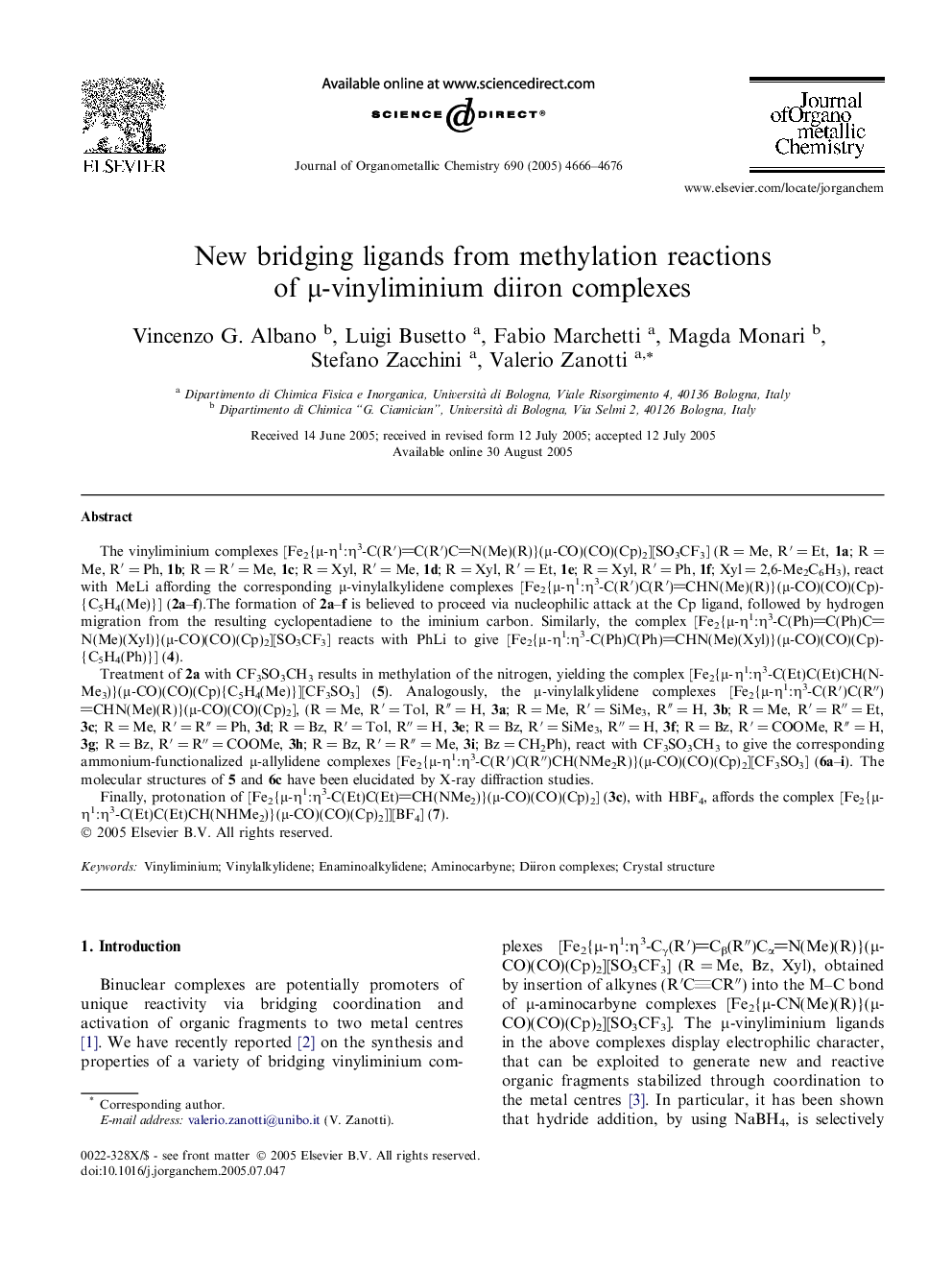| Article ID | Journal | Published Year | Pages | File Type |
|---|---|---|---|---|
| 1326229 | Journal of Organometallic Chemistry | 2005 | 11 Pages |
The vinyliminium complexes [Fe2{μ-η1:η3-C(R′)C(R′)CN(Me)(R)}(μ-CO)(CO)(Cp)2][SO3CF3] (R = Me, R′ = Et, 1a; R = Me, R′ = Ph, 1b; R = R′ = Me, 1c; R = Xyl, R′ = Me, 1d; R = Xyl, R′ = Et, 1e; R = Xyl, R′ = Ph, 1f; Xyl = 2,6-Me2C6H3), react with MeLi affording the corresponding μ-vinylalkylidene complexes [Fe2{μ-η1:η3-C(R′)C(R′)CHN(Me)(R)}(μ-CO)(CO)(Cp){C5H4(Me)}] (2a–f). The formation of 2a–f is believed to proceed via nucleophilic attack at the Cp ligand, followed by hydrogen migration from the resulting cyclopentadiene to the iminium carbon. Similarly, the complex [Fe2{μ-η1:η3-C(Ph)C(Ph)CN(Me)(Xyl)}(μ-CO)(CO)(Cp)2][SO3CF3] reacts with PhLi to give [Fe2{μ-η1:η3-C(Ph)C(Ph)CHN(Me)(Xyl)}(μ-CO)(CO)(Cp){C5H4(Ph)}] (4).Treatment of 2a with CF3SO3CH3 results in methylation of the nitrogen, yielding the complex [Fe2{μ-η1:η3-C(Et)C(Et)CH(NMe3)}(μ-CO)(CO)(Cp){C5H4(Me)}][CF3SO3] (5). Analogously, the μ-vinylalkylidene complexes [Fe2{μ-η1:η3-C(R′)C(R″)CHN(Me)(R)}(μ-CO)(CO)(Cp)2], (R = Me, R′ = Tol, R″ = H, 3a; R = Me, R′ = SiMe3, R″ = H, 3b; R = Me, R′ = R″ = Et, 3c; R = Me, R′ = R″ = Ph, 3d; R = Bz, R′ = Tol, R″ = H, 3e; R = Bz, R′ = SiMe3, R″ = H, 3f; R = Bz, R′ = COOMe, R″ = H, 3g; R = Bz, R′ = R″ = COOMe, 3h; R = Bz, R′ = R″ = Me, 3i; Bz = CH2Ph), react with CF3SO3CH3 to give the corresponding ammonium-functionalized μ-allylidene complexes [Fe2{μ-η1:η3-C(R′)C(R″)CH(NMe2R)}(μ-CO)(CO)(Cp)2][CF3SO3] (6a–i). The molecular structures of 5 and 6c have been elucidated by X-ray diffraction studies.Finally, protonation of [Fe2{μ-η1:η3-C(Et)C(Et)CH(NMe2)}(μ-CO)(CO)(Cp)2] (3c), with HBF4, affords the complex [Fe2{μ-η1:η3-C(Et)C(Et)CH(NHMe2)}(μ-CO)(CO)(Cp)2]][BF4] (7).
Graphical abstractMethyllithium addition at the Cp ligand of the diiron vinyliminium complexes 1 is followed by hydrogen migration from the C5H5Me ring to the iminium carbon. Bridging vinylcarbene complexes of type 2 are consequently formed. Treatment of 2 with MeSO3CF3 selectively produces the methylation of the nitrogen atom, affording the ammonium μ-allylidene 5.Figure optionsDownload full-size imageDownload as PowerPoint slide
